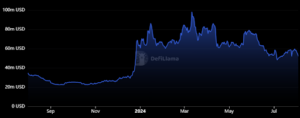Metis, a leading Ethereum L2, has announced a significant upgrade to its technological stack with the introduction of sequencer mining withdrawals.
Earlier this year, in April, the Metis team had initiated the rollout of its rewards for sequencer node operators and token lockers, transaction pools, and the inclusion of multiple transactions within a single block.
The move enabled ordinary users to earn sequencer mining rewards by locking their METIS tokens on a sequencer node by way of liquid staking token (LST) providers. Users that do this receive LSTs that represent their locked METIS and earn rewards. Node operators also have the ability to earn yields on LSTs.
In this context, the launch of sequencer mining withdrawals on Metis marks a pivotal moment in the network’s evolution, as it allows users and node operators to access their locked assets with greater capital flexibility.
To elaborate, the system introduces two types of withdrawals for node operators: i.e. partial and full. Partial withdrawals, as the name suggests, enable operators to withdraw tokens above the pre-designated threshold of 20,000 METIS.
Full withdrawals, on the other hand, allow node operators to exit the network entirely after a 21-day waiting period, providing a clear and secure process for those looking to conclude their participation.
Furthermore, the latest development also ensures that users interacting with the network through Liquid Staking Token (LST) partners like Artemis and Enki can easily manage their assets without sacrificing network security or efficiency.
Lastly, by executing withdrawals via L1 smart contracts, Metis leverages Ethereum’s robust security infrastructure to ensure the safety and integrity of all transactions — while concurrently maintaining the stability of its native network.
Welcoming Independent Sequencer Node
In another significant move to further its decentralization, Metis has recently started onboarding independent sequencer nodes that were selected by the community through governance, including industry giants such as HashKey Cloud and OKX.
HashKey Cloud, a prominent Web3 infrastructure provider in Asia, brings its expertise in delivering professional, stable, and secure blockchain services. The company received an impressive 99.95% approval with 96,000 METIS tokens used for voting .
Similarly, OKX, a globally recognized crypto exchange and Web3 company, has also joined Metis as a sequencer node operator with the same level of approval and token votes as HashKey. The collaboration seeks to enhance the latter’s security as well as bring valuable industry experience and technological prowess to the ecosystem.
Driving Network Growth Sustainably
The introduction of sequencer mining withdrawals seems to be part of Metis’ broader strategy to encourage network participation and growth.
By offering more flexible token locking and withdrawal options, Metis aims to attract a wider range of participants to its ecosystem. This is an aspect that aligns with the aforementioned launch of its Phase 2 decentralized sequencer upgrade, which introduced rewards for token lockers and node operators.
As highlighted earlier, the “Sequencer Mining” mechanism allows users to generate yields by locking assets through its LST providers, thus providing new avenues for passive valuegeneration as well as improving network decentralization and security.
Metis’ commitment to ecosystem growth is further bolstered by its selection of Artemis Finance and Enki Protocol as LST providers. Artemis and Enki are liquid staking token protocols designed exclusively for Metis’ Decentralized Sequencer Pools
Additionally, the allocation of 220,000 METIS (approximately $14.6 million) in grants for LST protocols this year underscores Metis’ investment in fostering a robust LST ecosystem.
The market has responded positively to Metis’ ongoing innovations, with its native token (METIS) having surged by 155% over the past year. Not only that, the total value locked (TVL) within the ecosystem has also surged considerably over the above said time frame — reflecting growing confidence in Metis’ technological potential.

Therefore, as the first L2 to offer decentralized transaction sequencing, Metis is continuing to push the boundaries of what’s possible within the Web3 industry. The launch of sequencer mining withdrawals, combined with the ongoing rollout of its decentralized sequencer upgrade, perfectly aligns the interests of node operators, token lockers, as well as all users, making the blockchain ecosystem more rewarding and participatory.



